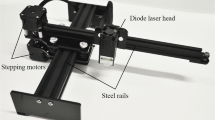Abstract
A solvent vapor treatment was applied to femtosecond-laser-ablated microchannels in PMMA to selectively restore the original hydrophilic wetting behavior of the pristine surface. The hydrophobic surface of the microchannels from the submicron porosity induced by ablation becomes smoother and more transparent after the treatment. This simple and low-cost method, together with suitable masking, can produce wettability patterns that may be exploited to develop passive microfluidic elements such as valves and mixers.








Similar content being viewed by others
References
Brandrup J, Immergut EH et al (1975) Polymer handbook. Wiley, New York
Cassie ABD, Baxter S (1944) Wettability of porous surfaces. Trans Faraday Soc 40:546–551
De Marco C, Eaton SM et al (2010) Surface properties of femtosecond-laser-ablated PMMA. ACS Appl Mater Interfaces 2(8):2377–2384
De Marco C, Eaton SM et al (2011) High-fidelity solvent-resistant replica molding of hydrophobic polymer surfaces produced by femtosecond laser nanofabrication. Langmuir 27(13):8391–8395
Kautek W, Rudolph P et al (2005) Physico-chemical aspects of femtosecond-pulse-laser-induced surface nanostructures. Appl Phys A Mater Sci Process 81(1):65–70
Kim E, Whitesides GM (1997) Imbibition and flow of wetting liquids in noncircular capillaries. J Phys Chem B 101(6):855–863
Ogilvie IRG, Sieben VJ et al (2010) Reduction of surface roughness for optical quality microfluidic devices in PMMA and COC. J Micromech Microeng 20(6):065016
Suriano RS, Kuznetsov RA et al (2011) Femtosecond laser ablation of polymeric substrates for the fabrication of microfluidic channels. Appl Surf Sci 257(14):6243–6250
Zhang P, Deng Y et al (2011) Design of shrinkage microvalve in microchannel with hydrophilic and hydrophobic walls. Microsyst Technol 17(9):1491–1495
Acknowledgments
We gratefully acknowledge financial support from the European Commission (microFLUID FP7 Project, Contract No. ICT-2007-224205), Regione Lombardia (MINILAB project, Contract no. MAN-18) and Fondazione CARIPLO (Contract no. 2010-0635).
Author information
Authors and Affiliations
Corresponding author
Rights and permissions
About this article
Cite this article
De Marco, C., Eaton, S.M., Martinez-Vazquez, R. et al. Solvent vapor treatment controls surface wettability in PMMA femtosecond-laser-ablated microchannels. Microfluid Nanofluid 14, 171–176 (2013). https://doi.org/10.1007/s10404-012-1035-2
Received:
Accepted:
Published:
Issue Date:
DOI: https://doi.org/10.1007/s10404-012-1035-2




